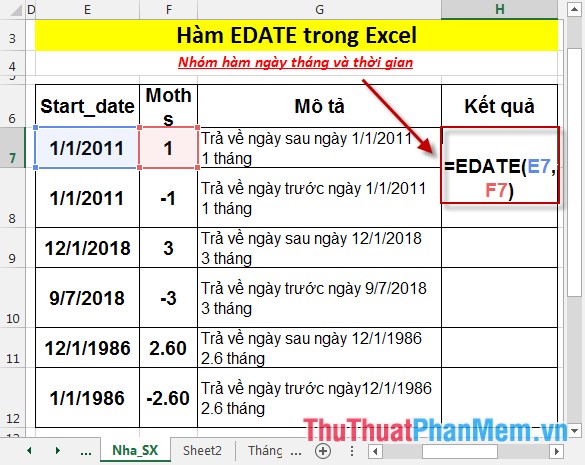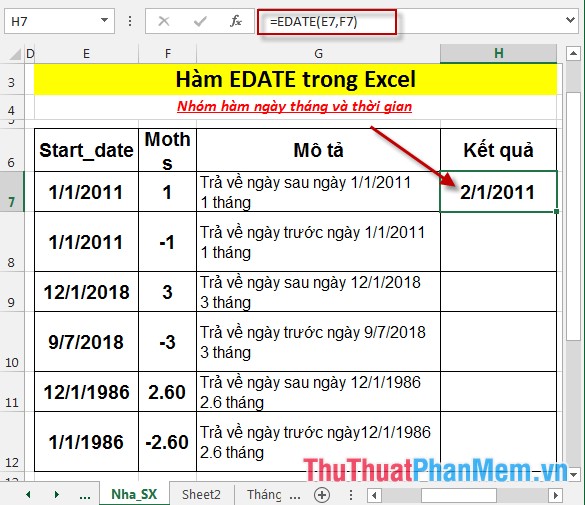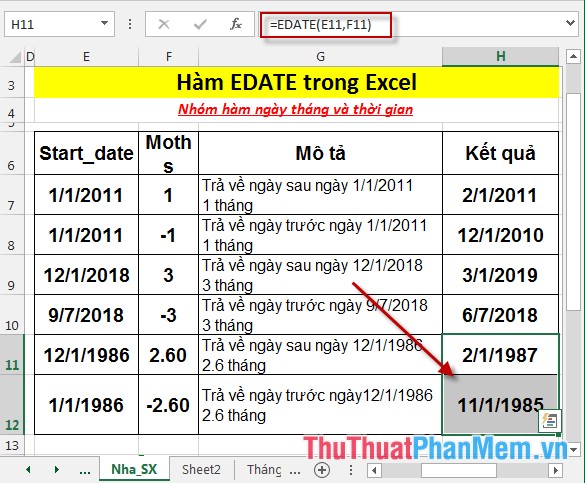EDATE function - Add and subtract months to a specified date in Excel
The following article introduces you to the EDATE function - one of the functions in the date and time group function is very popular in Excel.

Description: The function performs addition (subtraction) of the month on the specified date. Use this function to calculate the due date that matches the release date in the month.
Syntax: EDATE (start_date, months)
Inside:
- start_date: The date represents the start date to add or subtract month values.
- months: The number of months to be added to start_date, the following cases:
+ months> 0 -> Create new days in the future.
+ months <0 -> Create new date in the past.
Attention:
- Excel stores the date as a serial number to facilitate the calculation process.
- If the start_date value is not a valid date -> the function returns the #VALUE! Error value
- Where the value moths is not an integer -> it is truncated to an integer.
For example:
Calculate the value of the day after adding or subtracting 1 month value in the table below:

- In the cell to calculate enter the formula: = EDATE (E7, F7).

- Press Enter -> days after 1/1/2011 1 month is:

- Similarly copying the formula for the remaining values results:

- Where the value of months is not an integer -> it is truncated to an integer.

The above are instructions and some specific examples when working with EDATE function in Excel.
Good luck!
You should read it
- DATE function - The date function in Excel
- Excel date function - Usage and examples
- DAY function - The function returns the date value of a specific date in Excel
- How to calculate time in Excel: Add and subtract time
- How to Subtract in Excel
- NOW function - The function returns the current date and time in Excel
- Calculation of age from date of birth in Excel
- How to use the SUMIF function in Excel
May be interested
- Calculation of age from date of birth in Excel
 the following article will guide you how to calculate the age from date of birth in excel so you can calculate the exact number of standard age in years, months and days. in the process of calculating age based on date of birth, the following cases occur: - case 1: calculates the usual age
the following article will guide you how to calculate the age from date of birth in excel so you can calculate the exact number of standard age in years, months and days. in the process of calculating age based on date of birth, the following cases occur: - case 1: calculates the usual age - Instructions on how to insert the current date in Excel
 in the process of working with spreadsheets, inserting date and time into the spreadsheet is the basic knowledge in excel. in addition to using the today () function to insert the current date, what other ways can we do?
in the process of working with spreadsheets, inserting date and time into the spreadsheet is the basic knowledge in excel. in addition to using the today () function to insert the current date, what other ways can we do? - How to use the WORKDAY function in Microsoft Excel
 in microsoft excel, the workday function is a function that deals with a date and time, and its purpose is to return the date before and after the specified number of working days.
in microsoft excel, the workday function is a function that deals with a date and time, and its purpose is to return the date before and after the specified number of working days. - DATEDIF function - The function calculates the number of days, months, years between 2 dates in Excel
 datedif function: the function performs the calculation of number of days, months, years between 2 dates in excel. functions are useful in formulas for calculating age numbers. syntax: datedif (start_date, end_date, unit)
datedif function: the function performs the calculation of number of days, months, years between 2 dates in excel. functions are useful in formulas for calculating age numbers. syntax: datedif (start_date, end_date, unit) - How to separate the date, month, and year columns into 3 different columns in Excel
 to separate the date, month and year in excel into separate values, we can do it with simple functions on excel.
to separate the date, month and year in excel into separate values, we can do it with simple functions on excel. - How to fix the date #VALUE error in Excel
 when entering a date-related formula in excel, some people are reported with the #value error, affecting the results in excel files.
when entering a date-related formula in excel, some people are reported with the #value error, affecting the results in excel files. - COUPNCD - The function returns the next coupon date in Excel
 currently, stock investment is no stranger to people, the matter is concerned daily. therefore, the following article introduces the coupncd function in detail to help you calculate the next coupon date.
currently, stock investment is no stranger to people, the matter is concerned daily. therefore, the following article introduces the coupncd function in detail to help you calculate the next coupon date. - How to fix date errors when copying to another Excel file
 when you copy the date to another excel file or change the date, it is 4 years and 1 day slower than the date in the file. so how to fix the error of displaying the wrong date when copying in excel?
when you copy the date to another excel file or change the date, it is 4 years and 1 day slower than the date in the file. so how to fix the error of displaying the wrong date when copying in excel? - TODAY function - The function returns the current date value in the format in Excel
 today function - the function returns the current date value in the format in excel. the today () function does not automatically update, but requires setting changes to control.
today function - the function returns the current date value in the format in excel. the today () function does not automatically update, but requires setting changes to control. - EOMONTH function - The function returns the last day in the month before or after 1 day of a specified number of months in Excel
 eomonth function: the function performs calculations and returns the last day in the month before or after 1 day a certain number of months. syntax: eomonth (start_date, months)
eomonth function: the function performs calculations and returns the last day in the month before or after 1 day a certain number of months. syntax: eomonth (start_date, months)










 HOUR function - The function returns the hour of a time value in Excel
HOUR function - The function returns the hour of a time value in Excel ISOWEEKNUM function - The function returns the ordinal number of the year of the week that contains the given date in Excel
ISOWEEKNUM function - The function returns the ordinal number of the year of the week that contains the given date in Excel MINUTE function - The function returns minutes of a time value in Excel
MINUTE function - The function returns minutes of a time value in Excel MONTH function - The function returns the monthly value of a day expressed as a serial number in Excel
MONTH function - The function returns the monthly value of a day expressed as a serial number in Excel NETWORKDAYS function - The function returns the number of whole working days between 2 dates in Excel
NETWORKDAYS function - The function returns the number of whole working days between 2 dates in Excel